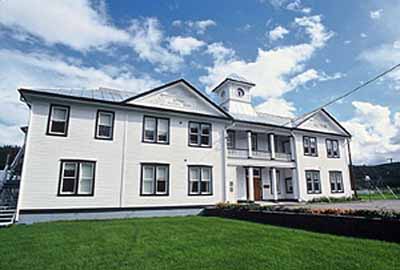Former Territorial Court House National Historic Site of Canada
Dawson, Yukon Territory

Facade
© Parks Canada Agency / Agence Parcs Canada, W. Lynch, 1995.
Address :
Corner of Front and Turner Streets, Dawson, Yukon Territory
Recognition Statute:
Historic Sites and Monuments Act (R.S.C., 1985, c. H-4)
Designation Date:
1981-01-15
Dates:
-
1900 to 1901
(Construction)
-
1901 to 1910
(Significant)
-
1914 to 1950
(Significant)
-
1954 to 1967
(Significant)
Event, Person, Organization:
-
Thomas W. Fuller
(Architect)
Other Name(s):
-
Former Territorial Court House
(Designation Name)
DFRP Number:
20032
Plaque(s)
Existing plaque: Corner of Front and Turner Streets, Dawson, Yukon Territory
Concern that Dawson's law courts should convey an air of dignity and stability within the community prompted replacement of the original 1898 log court house with this substantial frame building in 1900-1901. It was designed, along with several other federal buildings in Dawson, by Department of Public Works architect Thomas W. Fuller. As Dawson's gold boom dwindled the volume of court cases declined, and trials ceased to be held at this court house in 1910. It subsequently served as headquarters for the Royal Northwest Mounted Police.
Description of Historic Place
The Former Territorial Court House National Historic Site of Canada is a handsome, two-storey wood-frame building designed in a classical style, on a prominent setting within the Dawson Historical Complex National Historic Site of Canada in Dawson, Yukon Territory. The building is distinguished by its imposing scale, regularly arranged two-over-two sash windows, and its metal hipped roof topped with a lantern. The building is now maintained by Parks Canada and serves as an important landmark on the streetscape. The designation refers to the building on its footprint.
Heritage Value
The Former Territorial Court House was designated a national historic site of Canada in 1980 because: it is representative of the judicial institution in Yukon Territory; this substantial frame building conveys an air of dignity and stability within the community.
Its heritage value resides in it identity as a symbol of the Canadian legal system as illustrated by its formal and functional design.
Purpose built to replace the original, inadequately sized log courthouse, the Former Territorial Court House was designed with two court chambers in order to accommodate the large volume of court business. The building of such an impressive structure in the remote location of Dawson was a clear physical statement of the Canadian government’s determination to establish and maintain a stable environment for the Dawson community. Designed by Department of Public Works architect, Thomas Fuller, the former court house was built from 1900 to 1901. When the court was relocated in 1910, the building was taken over by the North West Mounted Police who re-allocated interior spaces for their own uses. In 1954, the Sisters of St Anne took it over for use as a hospital. They carried out further interior alterations and added a new wing, but maintained the integrity of the original exterior elevations. Today, the building is maintained by Parks Canada as part of the Dawson Historical Complex National Historic Site of Canada.
Source: Historic Sites and Monuments Board of Canada, Minutes, June 1980.
Character-Defining Elements
Aspects of this site that contribute to its heritage value include: the building’s orientation and prominent location within the townsite; the monumental presence and dominant profile of the building with its long, rectangular two-and-a-half-storey massing under a metal hipped roof topped with a lantern; its classically inspired design with its symmetrically organized multi-bay façade with a central entry, slightly projecting pedimented flanking pavilions, and details such as the second-storey balcony over the entrance with columns and balustrade; its wood-frame construction adapted to cope with permafrost and fine finishing details, all evocative of high standards of craftsmanship; the surviving major public spaces in their original axial configuration, materials, and workmanship relating to the building’s original function as a court house; the viewscapes and relationship between the building and other historic buildings comprising the Dawson Historical Complex National Historic Site of Canada.